Minfeng Zhu
GenesisGeo: Technical Report
Sep 26, 2025Abstract:We present GenesisGeo, an automated theorem prover in Euclidean geometry. We have open-sourced a large-scale geometry dataset of 21.8 million geometric problems, over 3 million of which contain auxiliary constructions. Specially, we significantly accelerate the symbolic deduction engine DDARN by 120x through theorem matching, combined with a C++ implementation of its core components. Furthermore, we build our neuro-symbolic prover, GenesisGeo, upon Qwen3-0.6B-Base, which solves 24 of 30 problems (IMO silver medal level) in the IMO-AG-30 benchmark using a single model, and achieves 26 problems (IMO gold medal level) with a dual-model ensemble.
VIS-Shepherd: Constructing Critic for LLM-based Data Visualization Generation
Jun 16, 2025Abstract:Data visualization generation using Large Language Models (LLMs) has shown promising results but often produces suboptimal visualizations that require human intervention for improvement. In this work, we introduce VIS-Shepherd, a specialized Multimodal Large Language Model (MLLM)-based critic to evaluate and provide feedback for LLM-generated data visualizations. At the core of our approach is a framework to construct a high-quality visualization critique dataset, where we collect human-created visualization instances, synthesize corresponding LLM-generated instances, and construct high-quality critiques. We conduct both model-based automatic evaluation and human preference studies to evaluate the effectiveness of our approach. Our experiments show that even small (7B parameters) open-source MLLM models achieve substantial performance gains by leveraging our high-quality visualization critique dataset, reaching levels comparable to much larger open-source or even proprietary models. Our work demonstrates significant potential for MLLM-based automated visualization critique and indicates promising directions for enhancing LLM-based data visualization generation. Our project page: https://github.com/bopan3/VIS-Shepherd.
Don't Reinvent the Wheel: Efficient Instruction-Following Text Embedding based on Guided Space Transformation
May 30, 2025
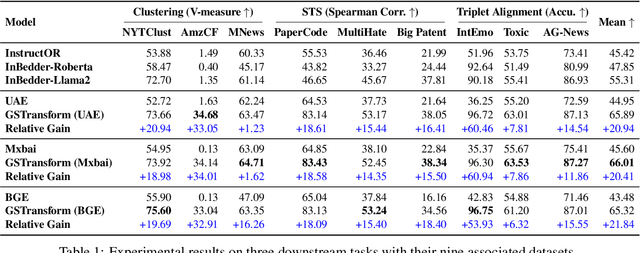
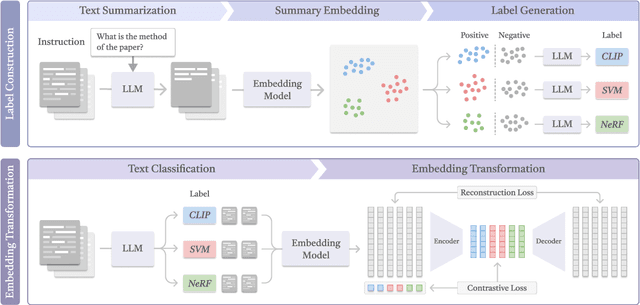

Abstract:In this work, we investigate an important task named instruction-following text embedding, which generates dynamic text embeddings that adapt to user instructions, highlighting specific attributes of text. Despite recent advancements, existing approaches suffer from significant computational overhead, as they require re-encoding the entire corpus for each new instruction. To address this challenge, we propose GSTransform, a novel instruction-following text embedding framework based on Guided Space Transformation. Our key observation is that instruction-relevant information is inherently encoded in generic embeddings but remains underutilized. Instead of repeatedly encoding the corpus for each instruction, GSTransform is a lightweight transformation mechanism that adapts pre-computed embeddings in real time to align with user instructions, guided by a small amount of text data with instruction-focused label annotation. We conduct extensive experiments on three instruction-awareness downstream tasks across nine real-world datasets, demonstrating that GSTransform improves instruction-following text embedding quality over state-of-the-art methods while achieving dramatic speedups of 6~300x in real-time processing on large-scale datasets. The source code is available at https://github.com/YingchaojieFeng/GSTransform.
Exploring Multimodal Prompt for Visualization Authoring with Large Language Models
Apr 18, 2025



Abstract:Recent advances in large language models (LLMs) have shown great potential in automating the process of visualization authoring through simple natural language utterances. However, instructing LLMs using natural language is limited in precision and expressiveness for conveying visualization intent, leading to misinterpretation and time-consuming iterations. To address these limitations, we conduct an empirical study to understand how LLMs interpret ambiguous or incomplete text prompts in the context of visualization authoring, and the conditions making LLMs misinterpret user intent. Informed by the findings, we introduce visual prompts as a complementary input modality to text prompts, which help clarify user intent and improve LLMs' interpretation abilities. To explore the potential of multimodal prompting in visualization authoring, we design VisPilot, which enables users to easily create visualizations using multimodal prompts, including text, sketches, and direct manipulations on existing visualizations. Through two case studies and a controlled user study, we demonstrate that VisPilot provides a more intuitive way to create visualizations without affecting the overall task efficiency compared to text-only prompting approaches. Furthermore, we analyze the impact of text and visual prompts in different visualization tasks. Our findings highlight the importance of multimodal prompting in improving the usability of LLMs for visualization authoring. We discuss design implications for future visualization systems and provide insights into how multimodal prompts can enhance human-AI collaboration in creative visualization tasks. All materials are available at https://OSF.IO/2QRAK.
R1-Onevision: Advancing Generalized Multimodal Reasoning through Cross-Modal Formalization
Mar 13, 2025Abstract:Large Language Models have demonstrated remarkable reasoning capability in complex textual tasks. However, multimodal reasoning, which requires integrating visual and textual information, remains a significant challenge. Existing visual-language models often struggle to effectively analyze and reason visual content, resulting in suboptimal performance on complex reasoning tasks. Moreover, the absence of comprehensive benchmarks hinders the accurate assessment of multimodal reasoning capabilities. In this paper, we introduce R1-Onevision, a multimodal reasoning model designed to bridge the gap between visual perception and deep reasoning. To achieve this, we propose a cross-modal reasoning pipeline that transforms images into formal textural representations, enabling precise language-based reasoning. Leveraging this pipeline, we construct the R1-Onevision dataset which provides detailed, step-by-step multimodal reasoning annotations across diverse domains. We further develop the R1-Onevision model through supervised fine-tuning and reinforcement learning to cultivate advanced reasoning and robust generalization abilities. To comprehensively evaluate multimodal reasoning performance across different grades, we introduce R1-Onevision-Bench, a benchmark aligned with human educational stages, covering exams from junior high school to university and beyond. Experimental results show that R1-Onevision achieves state-of-the-art performance, outperforming models such as GPT-4o and Qwen2.5-VL on multiple challenging multimodal reasoning benchmarks.
DataLab: A Unified Platform for LLM-Powered Business Intelligence
Dec 04, 2024
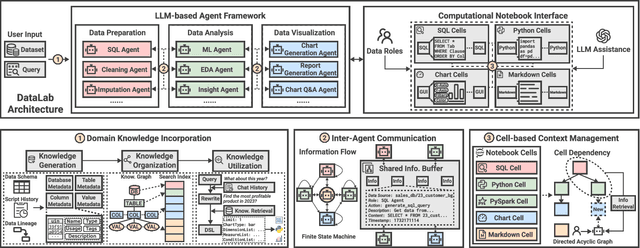

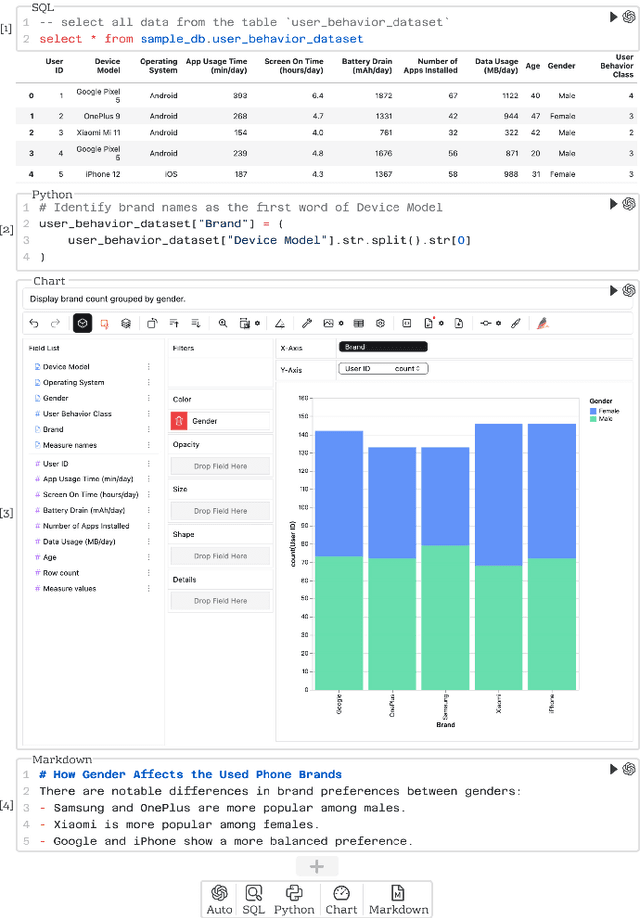
Abstract:Business intelligence (BI) transforms large volumes of data within modern organizations into actionable insights for informed decision-making. Recently, large language model (LLM)-based agents have streamlined the BI workflow by automatically performing task planning, reasoning, and actions in executable environments based on natural language (NL) queries. However, existing approaches primarily focus on individual BI tasks such as NL2SQL and NL2VIS. The fragmentation of tasks across different data roles and tools lead to inefficiencies and potential errors due to the iterative and collaborative nature of BI. In this paper, we introduce DataLab, a unified BI platform that integrates a one-stop LLM-based agent framework with an augmented computational notebook interface. DataLab supports a wide range of BI tasks for different data roles by seamlessly combining LLM assistance with user customization within a single environment. To achieve this unification, we design a domain knowledge incorporation module tailored for enterprise-specific BI tasks, an inter-agent communication mechanism to facilitate information sharing across the BI workflow, and a cell-based context management strategy to enhance context utilization efficiency in BI notebooks. Extensive experiments demonstrate that DataLab achieves state-of-the-art performance on various BI tasks across popular research benchmarks. Moreover, DataLab maintains high effectiveness and efficiency on real-world datasets from Tencent, achieving up to a 58.58% increase in accuracy and a 61.65% reduction in token cost on enterprise-specific BI tasks.
DataLab: A Unifed Platform for LLM-Powered Business Intelligence
Dec 03, 2024



Abstract:Business intelligence (BI) transforms large volumes of data within modern organizations into actionable insights for informed decision-making. Recently, large language model (LLM)-based agents have streamlined the BI workflow by automatically performing task planning, reasoning, and actions in executable environments based on natural language (NL) queries. However, existing approaches primarily focus on individual BI tasks such as NL2SQL and NL2VIS. The fragmentation of tasks across different data roles and tools lead to inefficiencies and potential errors due to the iterative and collaborative nature of BI. In this paper, we introduce DataLab, a unified BI platform that integrates a one-stop LLM-based agent framework with an augmented computational notebook interface. DataLab supports a wide range of BI tasks for different data roles by seamlessly combining LLM assistance with user customization within a single environment. To achieve this unification, we design a domain knowledge incorporation module tailored for enterprise-specific BI tasks, an inter-agent communication mechanism to facilitate information sharing across the BI workflow, and a cell-based context management strategy to enhance context utilization efficiency in BI notebooks. Extensive experiments demonstrate that DataLab achieves state-of-the-art performance on various BI tasks across popular research benchmarks. Moreover, DataLab maintains high effectiveness and efficiency on real-world datasets from Tencent, achieving up to a 58.58% increase in accuracy and a 61.65% reduction in token cost on enterprise-specific BI tasks.
MePT: Multi-Representation Guided Prompt Tuning for Vision-Language Model
Aug 19, 2024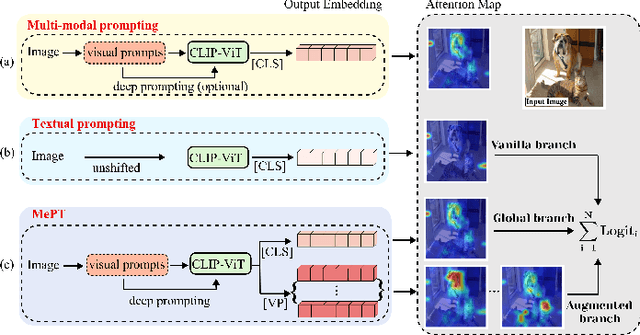
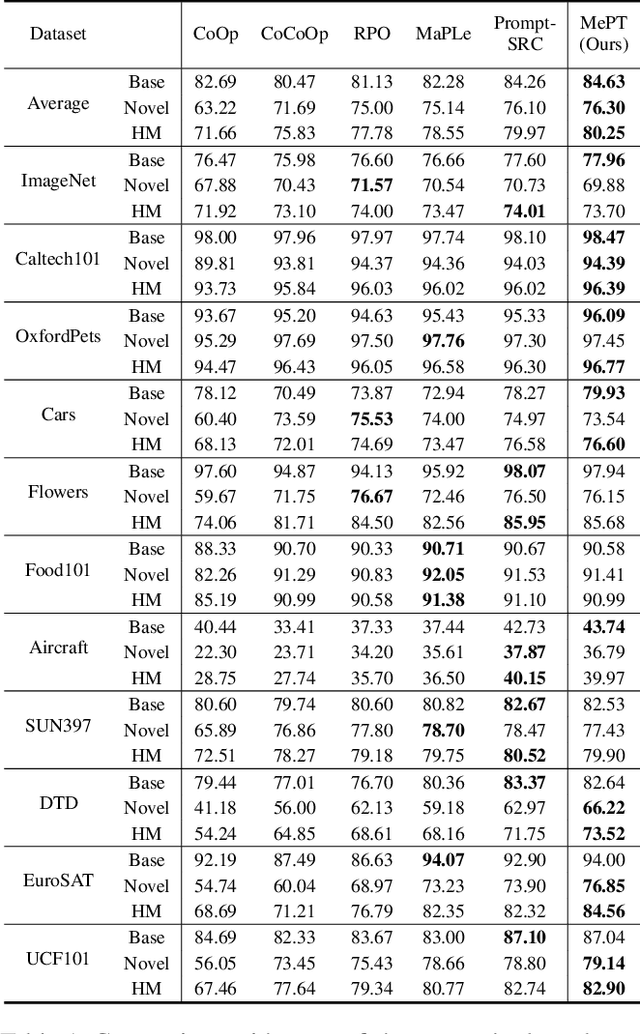
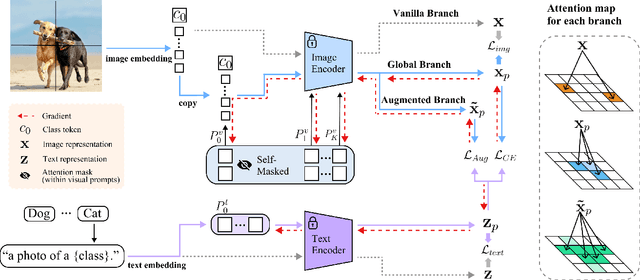

Abstract:Recent advancements in pre-trained Vision-Language Models (VLMs) have highlighted the significant potential of prompt tuning for adapting these models to a wide range of downstream tasks. However, existing prompt tuning methods typically map an image to a single representation, limiting the model's ability to capture the diverse ways an image can be described. To address this limitation, we investigate the impact of visual prompts on the model's generalization capability and introduce a novel method termed Multi-Representation Guided Prompt Tuning (MePT). Specifically, MePT employs a three-branch framework that focuses on diverse salient regions, uncovering the inherent knowledge within images which is crucial for robust generalization. Further, we employ efficient self-ensemble techniques to integrate these versatile image representations, allowing MePT to learn all conditional, marginal, and fine-grained distributions effectively. We validate the effectiveness of MePT through extensive experiments, demonstrating significant improvements on both base-to-novel class prediction and domain generalization tasks.
JailbreakLens: Visual Analysis of Jailbreak Attacks Against Large Language Models
Apr 12, 2024



Abstract:The proliferation of large language models (LLMs) has underscored concerns regarding their security vulnerabilities, notably against jailbreak attacks, where adversaries design jailbreak prompts to circumvent safety mechanisms for potential misuse. Addressing these concerns necessitates a comprehensive analysis of jailbreak prompts to evaluate LLMs' defensive capabilities and identify potential weaknesses. However, the complexity of evaluating jailbreak performance and understanding prompt characteristics makes this analysis laborious. We collaborate with domain experts to characterize problems and propose an LLM-assisted framework to streamline the analysis process. It provides automatic jailbreak assessment to facilitate performance evaluation and support analysis of components and keywords in prompts. Based on the framework, we design JailbreakLens, a visual analysis system that enables users to explore the jailbreak performance against the target model, conduct multi-level analysis of prompt characteristics, and refine prompt instances to verify findings. Through a case study, technical evaluations, and expert interviews, we demonstrate our system's effectiveness in helping users evaluate model security and identify model weaknesses.
Self-Distillation Bridges Distribution Gap in Language Model Fine-Tuning
Feb 21, 2024



Abstract:The surge in Large Language Models (LLMs) has revolutionized natural language processing, but fine-tuning them for specific tasks often encounters challenges in balancing performance and preserving general instruction-following abilities. In this paper, we posit that the distribution gap between task datasets and the LLMs serves as the primary underlying cause. To address the problem, we introduce Self-Distillation Fine-Tuning (SDFT), a novel approach that bridges the distribution gap by guiding fine-tuning with a distilled dataset generated by the model itself to match its original distribution. Experimental results on the Llama-2-chat model across various benchmarks demonstrate that SDFT effectively mitigates catastrophic forgetting while achieving comparable or superior performance on downstream tasks compared to the vanilla fine-tuning. Moreover, SDFT demonstrates the potential to maintain the helpfulness and safety alignment of LLMs. Our code is available at \url{https://github.com/sail-sg/sdft}.
 Add to Chrome
Add to Chrome Add to Firefox
Add to Firefox Add to Edge
Add to Edge